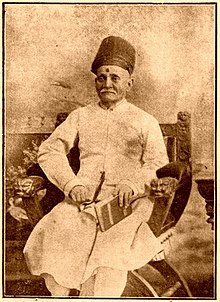Premchand Roychand
Premchand Roychand | |
|---|---|
 | |
| Born | March 1832 Surat, Gujarat, India |
| Died | March 1906 (aged 74–75) |
| Occupation(s) | Stockbroker and businessman |
| Notable work | Donor of Rajabai Clock Tower |
Premchand Roychand Jain (1832–1906) was an Indian businessman known as the "Cotton King" and "Bullion King" from Bombay.[1]
Life[edit]
Premchand Raichand Jain was born in 1832 in a Porwal ] family. He was the son of Roychand Dipchand Ji Jain, a merchant from Surat. The Roychand family moved to Bombay when Premchand was a young boy. He was educated at Elphinstone College. Recorded as the first Indian broker able to speak, read and write English, he entered the lists as a stock broker in 1849. Apart from the capital markets, Jain had significant business interests in the cotton and bullion trades along with the stock market. He was a founding member of The Native Share & Stock Brokers Association which is now Bombay Stock Exchange, the second largest stock exchange of India.[2] He earned significant profits from the cotton boom which was triggered by the start of the American Civil War in April 1861 which stayed till 1865.[2][3][4][5]
He lost the majority of his fortune in the Backbay reclamation scheme, and other such ventures.[6] He subsequently earned a portion of it back and turned to philanthropic ventures. The Rajabai Clock Tower in the University of Bombay was named for his mother and was built from a donation of ₹200,000 in 1878.[2][7] He was director of the Bank of Bombay, the largest in the Bombay Presidency.[4] He also invested in other schools, including many for girls such as J.B. Petit High School for Girls; he also established the "Premchand Roychand Award" for outstanding art students with the University of Calcutta. He also donated to the Asiatic Society.[2][8][5]
He died in 1906. His bungalow in Byculla that he named Premodayan became Regina Pacis Convent, an orphanage and school for destitute girls.[9][5]
Legacy[edit]
Premchand Roychand Scholarship award was started by Premchand Roychand Jain in 1866. It is very old and prestigious scholarship award. Each year this competition and award is organized by University of Calcutta.[10][11]
Further reading[edit]
- Sharada Dwivedi (2006). Premchand Roychand (1831-1906): His Life and Times. Eminence Designs. ISBN 978-81-903821-1-3.
References[edit]
- ^ Mishra, Ashish K. (23 May 2015). "Premchand Roychand: Mumbai's original share king". mint. Retrieved 14 September 2020.
- ^ a b c d Mishra, Ashish K. (23 May 2015). "Premchand Roychand: Mumbai's original share king". Livemint. Retrieved 27 July 2016.
- ^ Kaul, Vivek (4 March 2007). "Mumbai's first realty bust was in 1865 | Latest News & Updates at Daily News & Analysis". DNA India. Retrieved 27 July 2016.
- ^ a b Lakshmi Subramanian (15 January 2016). Three Merchants of Bombay: Business Pioneers of the Nineteenth Century. Penguin Books Limited. pp. 122–130. ISBN 978-81-8475-721-7.
- ^ a b c "Premchand Roychand and Bombay dreams". The Hindu Business Line. 14 February 2010. Retrieved 18 July 2017.
- ^ "An insane interlude in history". www.rediff.com. Retrieved 18 July 2017.
- ^ Rakesh Kumar Bhatt (1 January 1995). History and Development of Libraries in India. Mittal Publications. pp. 39–40. ISBN 978-81-7099-582-1.
- ^ Sunavala, Nergish (19 June 2016). "Schools get architects to save a chapter of their own history - Times of India". Times of India. Retrieved 27 July 2016.
- ^ "This home stood witness to the hands that built Bombay". The Indian Express. 21 January 2014. Retrieved 18 July 2017.
- ^ "Distinguished Alumni". www.caluniv.ac.in.
- ^ Mishra, Ashish K. (23 May 2015). "Premchand Roychand: Mumbai's original share king". mint.
